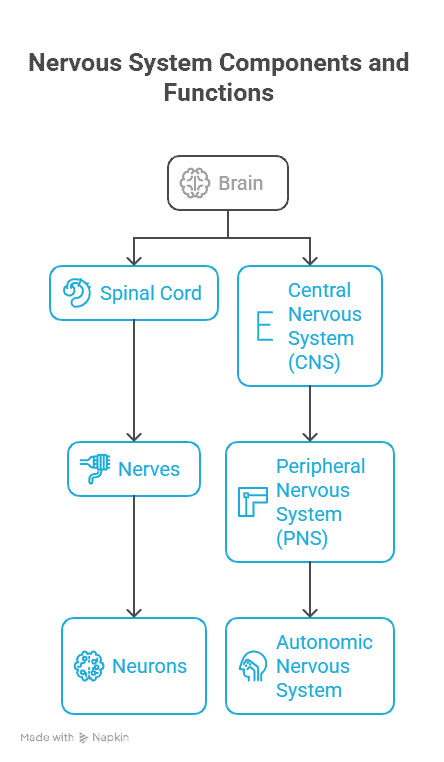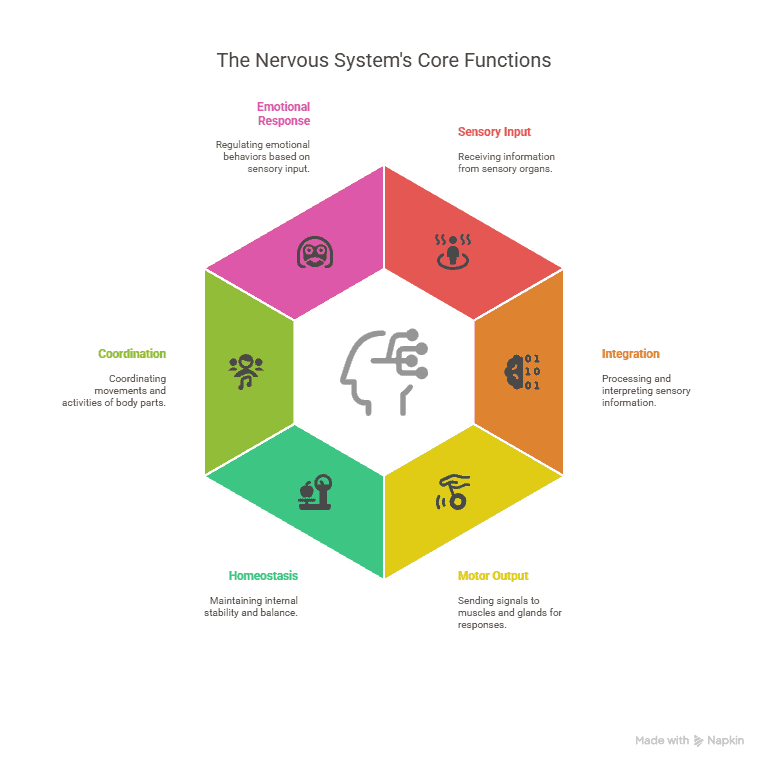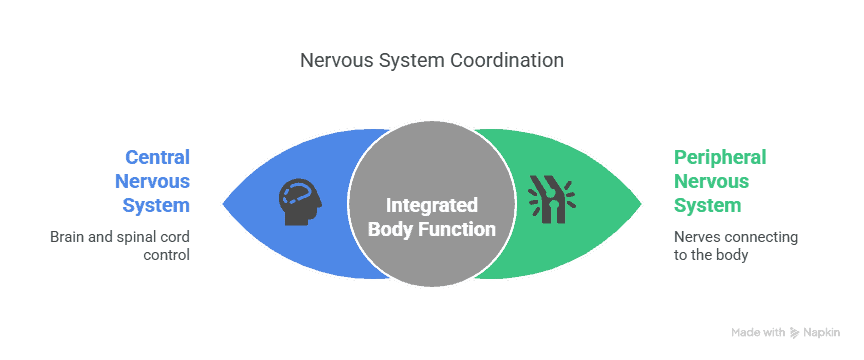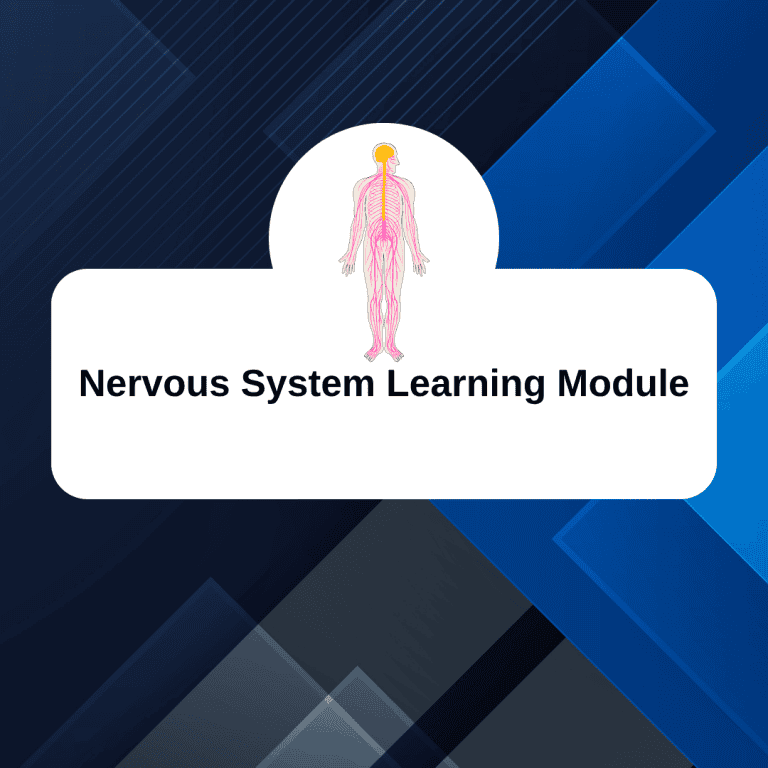Section 1: The Nervous System
What is the Nervous System?
The nervous system is like the body’s messaging system. It helps us think, feel, move, and react to things around us. It is made up of the brain, spinal cord, and nerves. The brain is like the control center, sending messages to the rest of the body. The spinal cord is like a highway, carrying messages between the brain and the rest of the body. Nerves are like wires, sending messages to and from the brain. Overall, the nervous system is a vital part of our bodies that enables us to function and respond to the world around us.
Structure of the Nervous System
In this section, we will learn about the central and peripheral nervous systems. The central nervous system includes the brain and spinal cord, which control all the body’s functions.
The peripheral nervous system consists of nerves that connect the central nervous system to the rest of the body. These nerves help us feel, move, and respond to the world around us. Understanding how these systems work together is crucial for pre-med students to become successful healthcare professionals.

| Part | Definition |
|---|---|
| Brain | The central organ of the nervous system responsible for processing sensory information, initiating voluntary movements, and regulating involuntary functions. |
| Spinal Cord | A long, thin, tubular bundle of nervous tissue that extends from the brain and is responsible for transmitting messages between the brain and the rest of the body. |
| Nerves | Bundles of fibers that transmit electrical impulses between the central nervous system and various parts of the body, allowing for communication and control of bodily functions. |
| Neurons | Specialized cells that transmit electrical and chemical signals in the nervous system, allowing for communication between different parts of the body. |
| Synapses | Junctions between neurons where electrical or chemical signals are transmitted from one neuron to another, allowing for communication and coordination of neural activity. |
Games and Activities
- Nervous System Quizzes
- Components of the Nervous System Flashcards
- Nervous System Vocabulary Hangman
Section 2: Neurons and Neurotransmitters
Neurons are like messengers in the nervous system, sending signals to help our body communicate. They are like tiny cells that pass along information through electrical impulses. Neurotransmitters are chemicals that help these signals travel from one neuron to another.
They act like messengers, carrying the signal across tiny gaps between neurons called synapses. When a signal reaches the end of a neuron, it triggers the release of neurotransmitters, which then bind to receptors on the next neuron, passing the message along. This process helps our body move, think, and feel.
| Neuron | Definition |
|---|---|
| Sensory Neuron | Neurons that transmit sensory information from the body to the brain. |
| Motor Neuron | Neurons that transmit signals from the brain to the muscles to produce movement. |
| Interneuron | Neurons that connect sensory and motor neurons, allowing for complex processing of information. |
| Neurotransmitter | Definition |
| Acetylcholine | A neurotransmitter involved in muscle movement, memory, and learning. |
| Dopamine | A neurotransmitter that regulates mood, motivation, and reward. |
| Serotonin | A neurotransmitter that affects mood, appetite, and sleep. |
Functions of the Nervous System
The nervous system is like the control center of our bodies. It helps us move, sense things, and perform other essential tasks. It sends messages from our brain to our muscles, instructing them when to move. It also helps us perceive sensations such as heat, cold, pain, and other forms of sensation.
The nervous system also helps regulate functions such as our heartbeat, breathing, and digestion. Therefore, it’s crucial for maintaining our bodies’ optimal functioning.

| Function | Definition |
|---|---|
| Sensory Input | Receiving information from sensory organs such as eyes, ears, skin, and taste buds. |
| Integration | Processing and interpreting sensory information to make decisions and send signals to the body. |
| Motor Output | Sending signals to muscles and glands to produce responses such as movement or secretion of hormones. |
| Homeostasis | Receiving information from sensory organs such as the eyes, ears, skin, and taste buds. |
| Coordination | Coordinating movements and activities of different body parts to achieve a common goal. |
| Emotional Response | Regulating emotional responses and behaviors based on sensory input and past experiences. |
Games and Activities
Section 3: Divisions of the Nervous System
Central vs. Peripheral Nervous System
The central nervous system (CNS) is the central hub of the body’s nervous system. It includes the brain and the spinal cord. It controls most of the body’s functions and helps us think, feel, and move.
On the other hand, the peripheral nervous system (PNS) is like the messenger. It carries messages from the CNS to the rest of the body. It includes all the nerves outside of the brain and spinal cord.
The PNS helps us perceive sensations such as pain and touch, and enables us to move our muscles. In summary, the central nervous system (CNS) is the control center, while the peripheral nervous system (PNS) is the messenger system that helps us interact with the world around us.

| Central Nervous System | Peripheral Nervous System |
|---|---|
| Consists of the brain and spinal cord | Consists of nerves outside of the brain and spinal cord |
| Responsible for processing and interpreting sensory information | Transmits sensory information to the CNS and carries motor commands from the CNS to muscles and glands |
| Controls voluntary and involuntary movements | Controls voluntary movements through skeletal muscles |
| Protected by the skull and vertebral column | Not protected by bones, vulnerable to damage |
| Composed of neurons and glial cells | Composed of sensory and motor neurons |
Somatic vs. Autonomic Nervous System
The somatic nervous system controls voluntary movements like walking and talking. It helps us interact with the world around us.
The autonomic nervous system controls involuntary actions like breathing and digesting food. It helps keep our body running smoothly without us having to think about it.
In summary, the somatic nervous system is for things we can control, while the autonomic nervous system is for things that happen automatically.
| Somatic Nervous System | Autonomic Nervous System |
|---|---|
| Controls voluntary movements | Controls involuntary body functions |
| Uses a single neuron pathway | Uses a two-neuron pathway |
| Neurotransmitter released is acetylcholine | Neurotransmitter released is acetylcholine or norepinephrine |
| Includes sensory and motor neurons | Includes sympathetic and parasympathetic divisions |
| Controls skeletal muscles | Controls smooth muscles, cardiac muscles, and glands |
Sympathetic vs. Parasympathetic Nervous System
The fight-or-flight response occurs when your body prepares to either fight or flee from danger. It’s controlled by the sympathetic system, which is like the gas pedal in a car. When this system is activated, your heart beats faster, your breathing gets quicker, and your muscles tense up.
On the other hand, the rest-and-digest response occurs when your body relaxes and focuses on activities such as eating and digesting food. This response is controlled by the parasympathetic system, which is like the brakes in a car. When this system is active, your heart rate slows down, your breathing becomes more regular, and your muscles relax.
Our bodies need to have a balance between these two systems to stay healthy.
| Sympathetic Nervous System | Parasympathetic Nervous System |
|---|---|
| Prepares the body for “fight or flight” response | Regulates the body at rest |
| Increases heart rate | Decreases heart rate |
| Dilates pupils | Constricts pupils |
| Stimulates the release of adrenaline | Stimulates digestion |
| Suppresses digestion | Stimulates salivation |
| Increases blood pressure | Decreases blood pressure |
Games and Activities
Section 4: Neurological Disorders
Alzheimer’s Disease
Alzheimer’s disease is a condition that affects the brain and causes memory loss, confusion, and difficulty with daily tasks. It can also lead to changes in mood and behavior. The exact cause of Alzheimer’s is not known, but it is believed to be related to a combination of genetic, environmental, and lifestyle factors.
There is currently no cure for Alzheimer’s, but there are treatments available that can help manage symptoms and slow the progression of the disease. These treatments may include medications, therapy, and lifestyle changes such as exercise and a healthy diet.
Parkinson’s Disease
Parkinson’s disease is a neurological disorder that affects movement. Some common motor symptoms include tremors, stiffness, and slow movements. Patients may also experience balance problems and difficulty walking.
Treatment options for Parkinson’s disease include medications that help increase dopamine levels in the brain to improve motor symptoms. Physical therapy and exercise can also help manage symptoms and improve the quality of life for patients with Parkinson’s disease.
Multiple Sclerosis
Multiple sclerosis is an autoimmune disease, which means that the body’s immune system mistakenly attacks its tissues. In the case of multiple sclerosis, the immune system targets the protective covering of nerve fibers in the brain and spinal cord, called myelin.
When the myelin is damaged, it disrupts the communication between the brain and the rest of the body. This can lead to a range of symptoms, including fatigue, weakness, numbness, and coordination difficulties.
Games and Activities
Conclusion
Congratulations on completing the module on the nervous system! You have successfully learned about the brain, spinal cord, and all the nerves that help our body function. Understanding how our nervous system works is crucial to understanding how our body responds to different stimuli and controls our movements.
By completing this module, you have taken a significant step toward understanding the complex network that enables us to think, feel, and move. Keep up the good work and continue to expand your knowledge of anatomy and physiology. Well done on your achievement!
What to Study Next?
It is recommended that you study the Cardiovascular system next. The Cardiovascular system is essential because it helps your heart pump blood throughout your body. By learning about the Cardiovascular system, you can understand how your heart works and how to keep it healthy.
This will help you learn more about how your body functions and how to maintain its health. So, make sure to focus on studying the Cardiovascular system after finishing the Nervous system. It will be a valuable addition to your knowledge about the human body.
